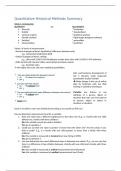Samenvatting
Quantitative Historical Methods Summary Week 1-8
- Vak
- Ch2216 (CH2216)
- Instelling
- Erasmus Universiteit Rotterdam (EUR)
Complete summary of Quantitative Historical Methods of week 1-8 with notes of all lectures, classes and readings. It might contain some Dutch explanations in case it needed some clarification.
[Meer zien]




